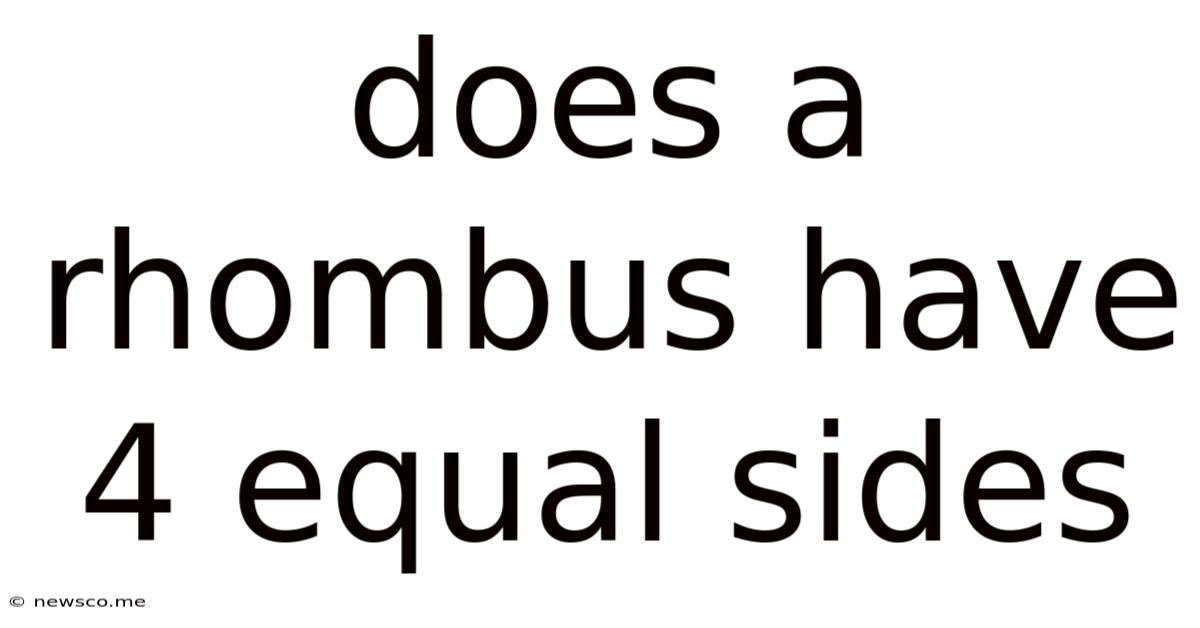Does A Rhombus Have 4 Equal Sides
News Co
Apr 21, 2025 · 5 min read

Table of Contents
Does a Rhombus Have 4 Equal Sides? A Deep Dive into Quadrilateral Geometry
The question, "Does a rhombus have 4 equal sides?" is a fundamental one in geometry, often encountered in elementary and high school mathematics. The simple answer is yes, a rhombus is defined by having four equal sides. However, understanding this fully requires exploring the broader world of quadrilaterals and their properties. This article will delve into the specifics of rhombuses, comparing them to other quadrilaterals, and examining the mathematical proofs that underpin their defining characteristics. We'll also explore some common misconceptions and applications of rhombus properties in various fields.
Understanding Quadrilaterals: A Family of Shapes
Before diving into the specifics of a rhombus, it's crucial to understand its place within the larger family of quadrilaterals. A quadrilateral is simply any polygon with four sides. This broad category encompasses a variety of shapes, each with its unique properties. Some key examples include:
- Trapezoid: A quadrilateral with at least one pair of parallel sides.
- Parallelogram: A quadrilateral with two pairs of parallel sides.
- Rectangle: A parallelogram with four right angles.
- Square: A rectangle with four equal sides.
- Rhombus: A parallelogram with four equal sides.
The Rhombus: A Special Parallelogram
As mentioned, a rhombus is a parallelogram with four equal sides. This makes it a more specific type of parallelogram, inheriting all the properties of parallelograms while possessing its unique characteristic: equal side lengths. Let's break down the key properties of a rhombus:
Key Properties of a Rhombus:
- Four equal sides: This is the defining characteristic of a rhombus. All four sides have the same length.
- Opposite sides are parallel: This is a property inherited from its parallelogram ancestry.
- Opposite angles are equal: Just like parallelograms, opposite angles within a rhombus are congruent (have the same measure).
- Consecutive angles are supplementary: Any two angles next to each other in a rhombus add up to 180 degrees.
- Diagonals bisect each other: The diagonals of a rhombus intersect at a point that divides each diagonal into two equal segments.
- Diagonals are perpendicular bisectors: The diagonals of a rhombus intersect at right angles and bisect each other. This means they cut each other in half and form four right angles at the intersection point.
Mathematical Proof: Why a Rhombus Has Four Equal Sides
The statement that a rhombus has four equal sides isn't just an observation; it's a fundamental part of its definition. However, we can explore this further using mathematical principles. Consider a parallelogram ABCD, where AB = CD and BC = DA (opposite sides are equal in a parallelogram). Now, let's add the condition that all sides are equal: AB = BC = CD = DA. This fulfills the definition of a rhombus. Therefore, the equality of sides is inherent to its definition.
We can also prove some of the other properties using vector algebra or coordinate geometry. For instance, we can demonstrate the perpendicularity of the diagonals using the dot product of vectors representing the diagonals. These proofs solidify the relationship between the equal sides and other properties of a rhombus.
Distinguishing a Rhombus from Other Quadrilaterals
It's essential to differentiate a rhombus from other quadrilaterals, particularly squares and parallelograms:
- Rhombus vs. Square: A square is a special case of a rhombus where all angles are also equal (90 degrees). Essentially, a square is a rhombus with right angles. Every square is a rhombus, but not every rhombus is a square.
- Rhombus vs. Parallelogram: A parallelogram only requires opposite sides to be parallel and equal in length. A rhombus adds the condition that all sides must be equal. Every rhombus is a parallelogram, but not every parallelogram is a rhombus.
Real-World Applications of Rhombuses
While seemingly abstract, the properties of rhombuses find practical applications in various fields:
- Engineering and Architecture: The strength and stability of a rhombus shape are utilized in structural designs, particularly in trusses and bridges. The equal sides distribute stress evenly, enhancing structural integrity.
- Crystallography: The crystalline structure of some materials exhibits rhombic shapes, influencing their optical and physical properties.
- Art and Design: Rhombuses are frequently used in artistic creations, tiling patterns, and graphic design, contributing to aesthetically pleasing and symmetrical compositions.
- Kites: Many kites are constructed in the shape of a rhombus, leveraging the aerodynamic properties of the shape for efficient flight.
Common Misconceptions about Rhombuses
A common misunderstanding is confusing rhombuses with squares or parallelograms. It's crucial to remember that a rhombus is a specific type of parallelogram, defined by its equal sides, and a square is a special case of a rhombus with right angles.
Conclusion: The Defining Characteristic of a Rhombus
In conclusion, the answer to the question "Does a rhombus have 4 equal sides?" is a resounding yes. This defining characteristic, coupled with its inheritance of parallelogram properties, makes the rhombus a unique and fascinating geometric shape with significant applications in various fields. Understanding the properties of a rhombus not only enhances mathematical knowledge but also provides a foundation for appreciating its importance in real-world applications. By exploring the nuances of its definition and properties, we can gain a deeper appreciation for the beauty and practicality of geometric shapes. Further study into advanced geometrical concepts, such as area calculations and the relationships between diagonals and sides, can unlock even more insights into this fundamental quadrilateral. The exploration of rhombuses serves as an excellent example of how seemingly simple geometric concepts can have complex and far-reaching implications.
Latest Posts
Related Post
Thank you for visiting our website which covers about Does A Rhombus Have 4 Equal Sides . We hope the information provided has been useful to you. Feel free to contact us if you have any questions or need further assistance. See you next time and don't miss to bookmark.